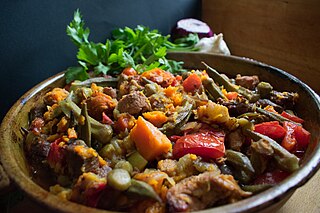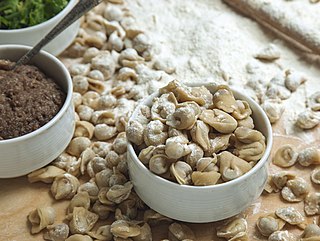
Turkish cuisine is the cuisine of Turkey and the Turkish diaspora. Although the cuisine took its current rich form after numerous cultural interactions throughout centuries, it should not be confused with other cuisines such as Ottoman cuisine or Seljuk cuisine. Turkish cuisine with traditional Turkic elements such as yogurt, ayran, kaymak, exerts and gains influences to and from Mediterranean, Balkan, Middle Eastern, Central Asian and Eastern European cuisines.

Kebab, kabob, kebap, or kabab (Kashmir) is roasted meat that originates from the Middle East. Many variants of the category are popular around the world, including the skewered shish kebab or souvlaki and the doner kebab or gyros with bread.

Dolma is a family of stuffed dishes associated with Turkish or Ottoman cuisine, typically made with a filling of rice, minced meat, offal, seafood, fruit, or any combination of these inside a vegetable or a leaf wrapping. Wrapped dolma, specifically, are known as sarma, made by rolling grape, cabbage, or other leaves around the filling. Dolma can be served warm or at room temperature and are common in modern cuisines of regions and nations that once were part of the Ottoman Empire.

Kibbeh is a popular dish in the Levant based on spiced lean ground meat and bulgur wheat. Kibbeh is considered to be a national dish of Lebanon and Syria.

Arab cuisine is the cuisine of the Arab world, defined as the various regional cuisines of the Arab people, spanning from the Maghreb to the Mashriq. These cuisines are centuries old and reflect the culture of trading in ingredients, spices, herbs, and commodities. The regions have many similarities, but also unique traditions. They have also been influenced by climate, cultivation, and mutual commerce.

Iranian cuisine is the culinary traditions of Iran. Due to the historically common usage of the term "Persia" to refer to Iran in the Western world, it is alternatively known as Persian cuisine, despite Persians being only one of a multitude of Iranian ethnic groups who have contributed to Iran's culinary traditions.

Iraqi cuisine is a Middle Eastern cuisine that has its origins in the ancient Near East culture of the fertile crescent. Tablets found in ancient ruins in Iraq show recipes prepared in the temples during religious festivals—the first cookbooks in the world. Ancient Mesopotamia was home to a sophisticated and highly advanced civilization, in all fields of knowledge, including the culinary arts.

Kofta is a family of meatball or meatloaf dishes found in South Asian, Central Asian, Balkan, Middle Eastern, North African, and South Caucasian cuisines. In the simplest form, koftas consist of balls of minced meat – usually beef, chicken, pork, lamb or mutton, or a mixture – mixed with spices and sometimes other ingredients. The earliest known recipes are found in early Arab cookbooks and call for ground lamb.

Levantine cuisine is the traditional cuisine of the Levant, in the sense of the rough area of former Ottoman Syria. The cuisine has similarities with Egyptian cuisine, North African cuisine and Ottoman cuisine. It is particularly known for its meze spreads of hot and cold dishes, most notably among them ful medames, hummus, tabbouleh and baba ghanoush, accompanied by bread.

Lebanese cuisine is the culinary traditions and practices originating from Lebanon. It includes an abundance of whole grains, fruits, vegetables, fresh fish and seafood. Poultry is eaten more often than red meat, and when red meat is eaten, it is usually lamb and goat meat. Dishes include copious amounts of garlic and olive oil, and dishes are often seasoned with lemon juice. Chickpeas and parsley are also staples of the Lebanese diet.

Khoresh or Khoresht is a generic Iranian term for stew dishes in the Iranian cuisine, Afghan cuisine, Tajik cuisine and also Kurdish cuisine. The word is a substantive of the verb khordan "to eat" and literally means "meal".

Tunisian cuisine, the cuisine of Tunisia, consists of the cooking traditions, ingredients, recipes and techniques developed in Tunisia since antiquity. It is mainly a blend of Mediterranean and native Punics-Berber cuisine. Historically, Tunisian cuisine witnessed influence and exchanges with many cultures and nations like Italians, Andalusians, French and Arabs.

Many cuisines feature eggplant salads and appetizers.

A meatball is ground meat (mince) rolled into a ball, sometimes along with other ingredients, such as bread crumbs, minced onion, eggs, butter, and seasoning. Meatballs are cooked by frying, baking, steaming, or braising in sauce. There are many types of meatballs using different types of meats and spices. The term is sometimes extended to meatless versions based on vegetables or fish; the latter are also commonly known as fish balls.

Türlü is a casserole of Turkish cuisine. It is made of stewed vegetables and may also include stewed meat. Varieties of this dish are also found in Balkan cuisines. In particular, it is known as turli perimesh in Albania, tourlou or tourlou tourlou in Greece, and as turli tava in North Macedonia.

Khoresh bademjan is a Persian stew of eggplant and tomatoes. The word khoresh means "stew," and bādemjān means "eggplant."

Garlic sauce is a sauce prepared using garlic as a primary ingredient. It is typically a pungent sauce, with the depth of garlic flavor determined by the amount of garlic used. The garlic is typically crushed or finely diced. Simple garlic sauce is composed of garlic and another ingredient to suspend the bulb via emulsion, such as oil, butter or mayonnaise. Various additional ingredients can be used to prepare the soup.

Joshpara is a kind of dumpling popular in Central Asia, South Caucasus and the Middle East. They are made of unleavened wheat dough squares filled with ground meat and condiments. In observance of the Islamic dietary rules, the meat filling is usually without pork.

Khoresh karafs is a traditional Iranian dish. As the name suggests, celery is the main part of this dish.


















